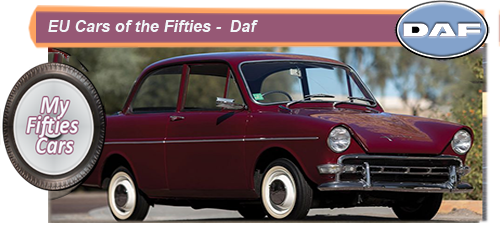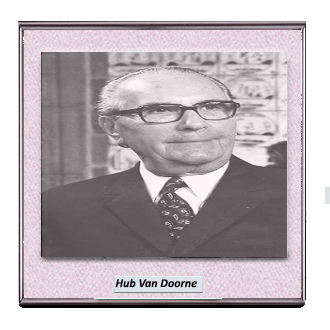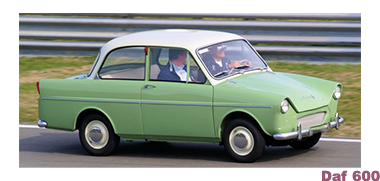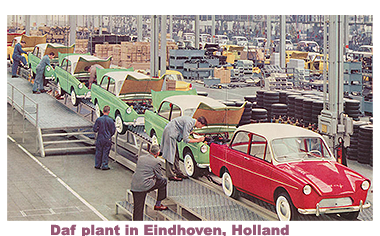 The history of the Daf Motor Company began to be written in the early Nineteen Thirties when Hubert Jozef van Doorne decided to expand his Eindhoven, Holland-based engineering firm into producing light vans and trucks.
The history of the Daf Motor Company began to be written in the early Nineteen Thirties when Hubert Jozef van Doorne decided to expand his Eindhoven, Holland-based engineering firm into producing light vans and trucks.
Hubert went into his new projct in the full understanding  that his engineering abilities far outweighed his business skills.
that his engineering abilities far outweighed his business skills.
 The older Van Doorne made the smart move of inviting his brother Wim to join the company to take care of administration and sales.
The older Van Doorne made the smart move of inviting his brother Wim to join the company to take care of administration and sales.
The brothers named their new initiative DAF- a derivation of Doorne's Aanhangwagen Fabriek- in simple terms Van Doorne's Trailer Factory.
The van Hoorne brother’s timing could have been better, as just as the truck manufacturing division had barely gotten underway when World War II broke out, meaning that production was switched to military vehicles.
In the immediate post-war years, DAF continued their efforts to conquer the commercial truck market in Holland and would likely have remained focused on that sector until Hubert van Doorne unveiled what would prove to be an industry-changing invention, the infinitely-variable, belt-driven automatic transmission, soon to be named the Variomatic.
Before its unveiling DAF carried out rigorous tests of the device including extensive treks across the roughest of desert terrains and hauling of trailers up mountainsides.
![]()
Power from the engine reached the rear wheels via a centrifugal clutch and two pairs of variable-diameter pulleys, each operated by a V-belt. A combination of engine vacuum and centrifugal weights determined the working diameter of the drive pulleys.
 At the other end of the system, spring and belt tension set the diameter of each driven pulley, bringing an infinite range of drive ratios using no gears at all and no clutch pedal.
At the other end of the system, spring and belt tension set the diameter of each driven pulley, bringing an infinite range of drive ratios using no gears at all and no clutch pedal.
Independent suspension on all four wheels also placed the DAF a step ahead of many cars of its era. So did the elimination of the need for chassis lubrication, and the use of rack-and-pinion steering.
Early in 1958, the first version of the prototype family saloon DAF 600 appeared at the Amsterdam auto show, with production getting underway in the spring of the following year.
arge enough to hold four grownups and a youngster (or so the company claimed), the initial DAF model was promoted as the "first family car to combine classic European beauty and craftsmanship with fully automatic driving at no extra cost."
![]()
 Not everyone who cast their eyes on the 600 for the first time, were overwhelmed ny it splendour. Instead the saw a car that was functional and well sclupted and certainly distinctive.
Not everyone who cast their eyes on the 600 for the first time, were overwhelmed ny it splendour. Instead the saw a car that was functional and well sclupted and certainly distinctive.
Most notable was the front view, with the hood sloped downward sharply at the front, so its leading edge was about level to the bottom of the headlamps.
That leading edge continued outward, over the headlights. giving them a shrouded appearance.
The 'DAF' s cript was mounted in the centre of the hood.
cript was mounted in the centre of the hood.
Farther down was a horizontal grille with angled upper corners and a very tight crosshatch mesh pattern.
An air-cooled. flat two-cylinder engine mounted in the front delivered 22 horsepower. Aluminium cylinders held steel sleeve inserts.
A centra l chassis backbone held a front leaf spring at the forward end and a fork for coil springs at the rear. Standard equipment included a heater, defroster, directional signals, safety-type steering wheel and sun visors.
l chassis backbone held a front leaf spring at the forward end and a fork for coil springs at the rear. Standard equipment included a heater, defroster, directional signals, safety-type steering wheel and sun visors.
By 1971, Hub van Doorne had begun to develop yet another transmission, this one fully automatic.
By the mid Seventies, Daf had gone as far as they could go as an independant and were slowly being swallowed up Volvo.
 By the mid-fifties. DAF, Holland's only ever car manufacturer, were fully acquired by the Swedish giant, who had made no secret of the fact that Daf's truck manufacturing capacity and expertise was of sole interest to them.
Possibly as a tribute to the the suess of the 600, Volvo ran a model that was very similr in design, the 340, which remained in production wich remained in production till the early Nineties.
By the mid-fifties. DAF, Holland's only ever car manufacturer, were fully acquired by the Swedish giant, who had made no secret of the fact that Daf's truck manufacturing capacity and expertise was of sole interest to them.
Possibly as a tribute to the the suess of the 600, Volvo ran a model that was very similr in design, the 340, which remained in production wich remained in production till the early Nineties.
Take me back to the Home Page

